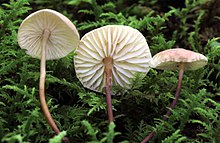|
Mycetinis
Mycetinis is a genus of fungus in the Omphalotaceae family, containing about eight species formerly classified in Marasmius.[2] GeneralThis group of mushrooms was long known as a section (Alliacei) within the more familiar genus Marasmius, which means that each of the species has a synonym under Marasmius. They are distinguished from other Marasmius by the hymeniform cap skin which consists of smooth cells, with hyphae which do not show a dextrinoid reaction. The species have a characteristic garlic smell.[3] DNA studies showed that the group is phylogenetically allied more to genus Gymnopus than to Marasmius, but the distinct structure of the cap skin is thought to justify a separation at the genus level. Franklin Sumner Earle had already defined the genus name Mycetinis for this group in 1909, though it had not caught on, and in 2005 Wilson & Desjardin proposed to resurrect this name and redefine it for the current taxonomy. The new phylogenetic classification also means that the group belongs to family Omphalotaceae instead of Marasmiaceae.[3][4] A new species, M. curraniae, was described in 2012. Species
References
|
||||||||||||||||||||||||||||||||||||||||||||||||||||||||||||||||||||||||||||||||||||||||||||||
Portal di Ensiklopedia Dunia












